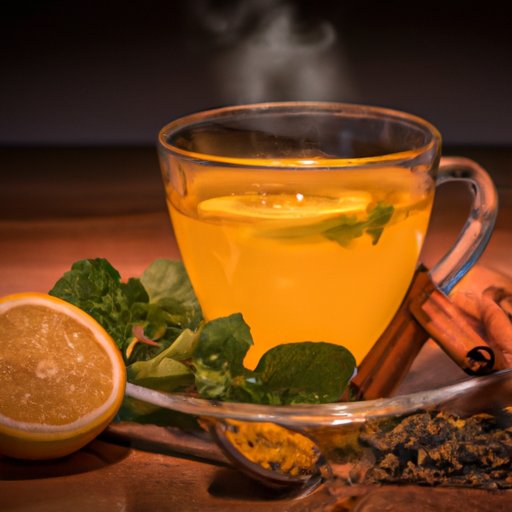Have you ever experienced the frustration of spilling turmeric tea on your carpet? It creates a vibrant mess that can be difficult to remove. This stubborn stain requires immediate action and the correct cleaning methods to effectively get rid of it. Swiftly addressing the spill and using the appropriate techniques is crucial to prevent lasting damage to your carpet.
In this article, I will share with you some natural and commercial cleaning solutions to get rid of turmeric tea stains from your carpet. Just like how every superhero has their weakness, every carpet has its Achilles heel when it comes to stains. For carpets, turmeric tea is one of them. It’s a stain that can easily become permanent if left unattended or cleaned improperly.
But don’t worry, with the right tools and techniques, you can save your carpet and restore it to its former glory. In this article, I will guide you through the process of removing turmeric tea stains from your carpet. From natural cleaning solutions to commercial cleaning products, I’ll give you all the information you need to get the job done right. So, let’s get started!
Key Takeaways
- Act quickly to prevent the stain from becoming permanent.
- Use natural or commercial cleaning solutions to remove the stain, but test on a small area first.
- Enzymatic cleaners work well for organic stains, while oxidizing agents are effective for chemical stains.
- Regular carpet maintenance, such as vacuuming and professional cleaning, can prevent damage and stains.
Act Fast
It’s imperative to act swiftly if you want to successfully remove turmeric tea from your carpet. Turmeric is notorious for leaving behind stubborn stains that can be difficult to get rid of, especially if left unattended. The longer the turmeric tea sits on your carpet, the more it will seep into the fibers and the harder it will be to remove. So, the first thing you need to do is act fast.
The first step to removing turmeric tea from your carpet is to blot gently with a clean cloth as soon as possible. This will help to absorb as much of the liquid as possible, preventing it from seeping deeper into the carpet fibers. Once you’ve blotted up as much of the liquid as possible, it’s time to move on to using vinegar and other natural cleaning solutions to tackle the stain.
Natural Cleaning Solutions
Using natural solutions for cleaning can be an effective way to remove stubborn stains, and there are many DIY recipes available that are both eco-friendly and easy to make. For removing turmeric tea from carpets, one option is a mixture of white vinegar and baking soda. Simply mix the two ingredients together to form a paste, apply it to the stain, and let it sit for a few minutes before blotting it up with a clean cloth. Another option is a mixture of hydrogen peroxide and dish soap. Mix equal parts of the two and apply it to the stain, then let it sit for a few minutes before blotting it up with a clean cloth.
There are many benefits of natural cleaners, such as being better for the environment and safer for your health than commercial cleaning products. Natural cleaners are often made from ingredients that you already have in your home, which can save you money and reduce waste. Additionally, natural cleaners are often just as effective as commercial products, making them a great choice for everyday cleaning needs. However, if natural solutions aren’t effective in removing the turmeric stain, it may be necessary to turn to commercial cleaning products for more heavy-duty cleaning.
Commercial Cleaning Products
When it comes to removing tough stains from carpets, there are a variety of commercial cleaning products that can be used. Carpet stain removers are a popular choice, as they’re designed to specifically target and remove stains from carpets.
Enzymatic cleaners are also effective, as they use natural enzymes to break down and remove stains. Finally, oxidizing agents like hydrogen peroxide can be used to lift and remove stubborn stains from carpets.
As someone who’s dealt with their fair share of carpet stains, I can attest to the effectiveness of these commercial cleaning products.
Carpet Stain Removers
To effectively remove carpet stains, you’ll need to choose a carpet stain remover that is appropriate for the type of stain and your carpet’s material. There are many commercial carpet stain removers available in the market that are specifically designed for various types of stains such as pet urine, coffee, wine, and more. These carpet stain removers come in various forms such as sprays, foams, and powders.
When choosing a carpet stain remover, make sure to read the label carefully and follow the instructions given. If you prefer to use DIY remedies, you can try using a mixture of vinegar and baking soda to remove the stain. However, be careful not to use too much vinegar as it can damage your carpet’s fibers.
If the stain is too stubborn and cannot be removed by commercial carpet stain removers or DIY remedies, you may need to consider hiring professional services. Professional carpet cleaners have specialized equipment and cleaning solutions that can effectively remove even the toughest stains.
With that being said, let’s move on to the next section where we will discuss enzymatic cleaners.
Enzymatic Cleaners
Enzymatic cleaners are like superheroes for your carpets, targeting and eliminating tough stains with precision and ease. They’re specially designed to break down organic compounds, such as proteins, fats, and oils, that are often found in stains caused by food, pet urine, and other biological sources.
Unlike traditional carpet cleaners, enzymatic cleaners work by using naturally occurring enzymes to digest and dissolve the stain molecules, leaving your carpet fresh and clean. Aside from their effectiveness, there are many benefits of using enzymatic cleaners.
They’re safe for use on a variety of surfaces, including carpets, upholstery, and clothing. They’re also environmentally friendly, as they don’t contain harsh chemicals that can pollute the air or water. Additionally, enzymatic cleaners are often more affordable than other carpet cleaning solutions and can be easily made at home using DIY enzymatic cleaner recipes.
Transitioning into the subsequent section about ‘oxidizing agents’, it’s important to note that while enzymatic cleaners are great for removing organic stains, they may not be as effective on other types of stains such as coffee or red wine. This is where oxidizing agents come in handy, as they work to break down the chemical structure of the stain and remove it from the carpet fibers.
Oxidizing Agents
You might be surprised to learn that oxidizing agents can be just as effective as enzymatic cleaners at removing tough stains from your carpets. Oxidizing agents work by causing a chemical reaction that breaks down the stain and bleaches the affected area. They are particularly effective at removing stains caused by turmeric tea, which can be notoriously difficult to get out of carpets.
One example of an oxidizing agent that can be used to remove turmeric tea stains is hydrogen peroxide. It’s important to note, however, that oxidizing agents can be powerful and should be used with caution. Before using any cleaning solution on your carpet, it’s always a good idea to test the cleaner first on an inconspicuous area to ensure that it doesn’t damage or discolor your carpet fibers.
With that in mind, let’s move on to the next step and talk about how to test the cleaner first.
Test the Cleaner First
First, make sure to test the cleaner on a small, inconspicuous area of the carpet before applying it to the turmeric stain. This is an important step in carpet cleaning because not all cleaning agents are compatible with all types of carpet fibers.
Here are some key things to keep in mind when spot testing a cleaner:
-
Check compatibility: Before using any cleaner, check the label to make sure it’s safe to use on your specific type of carpet. Some cleaners may be too harsh for delicate fibers, while others may not be effective on certain types of stains.
-
Spot test: Apply a small amount of the cleaner to an inconspicuous area of the carpet and let it sit for a few minutes. Then, use a clean white cloth to blot the area. If the cloth comes away clean, the cleaner is safe to use on your carpet.
-
Take note of any discoloration: If the cleaner causes any discoloration or damage to the carpet fibers during the spot test, do not use it on the turmeric stain.
With these tips in mind, you can be confident that the cleaner you use will be effective without causing any further damage to your carpet.
Now, it’s time to move on to applying the cleaner to the turmeric stain.
Apply the Cleaner
Now it’s time to start applying the cleaner to the stained area, making sure to follow the instructions on the label carefully. Proper application is crucial to ensure that the turmeric tea stain is completely removed from your carpet.
Start by applying a small amount of the cleaner to the affected area, and gently scrub it in using a clean cloth or sponge. Be careful not to scrub too hard, as this can damage the carpet fibers.
Once you have applied the cleaner, allow it to sit for the recommended amount of time. This will vary depending on the product you’re using, so make sure to read the label carefully.
After the appropriate drying time, use a clean, damp cloth or sponge to blot the area and remove any excess cleaner.
Now that you have applied the cleaner and allowed it to sit, it’s time to move on to the next step: rinsing thoroughly.
Rinse Thoroughly
After letting the cleaner sit for the recommended time, it’s important to rinse the area thoroughly to ensure all residue is removed. To do this, follow these steps:
-
Use a clean, damp cloth to gently blot the affected area, being careful not to rub or scrub the carpet fibers.
-
Repeat this process with fresh water until all of the cleaner and turmeric tea have been removed.
-
Once the area has been thoroughly rinsed, use a dry towel or paper towels to blot up any excess moisture.
-
Finally, allow the carpet to air dry completely before walking on it or replacing any furniture.
Preventive measures such as using a barrier mat or placing a towel under your tea cup can help to avoid future spills on your carpet. Additionally, proper drying techniques are crucial to prevent mold and mildew growth. If the area is not completely dry after blotting, consider using a fan or dehumidifier to speed up the drying process.
Repeat if necessary to ensure all stains have been removed before moving on to the final step.
Repeat if Necessary
If you still notice any stubborn stains on your carpet after rinsing thoroughly, don’t hesitate to repeat the cleaning process until the affected area is completely spotless. There are various effective techniques that you can use to remove turmeric tea stains from your carpet, so you can choose to repeat the same method or try a different one. However, it’s essential to avoid common mistakes such as rubbing the affected area vigorously or using bleach, which can cause further damage to your carpet.
One technique that you can try is using a mixture of dish soap and warm water to blot the stain. Simply mix a few drops of dish soap with warm water, and use a clean cloth to blot the affected area gently. You can repeat this process until the stain disappears completely.
Another option is to use a mixture of baking soda and vinegar. Mix a tablespoon of baking soda with a tablespoon of vinegar, and apply the mixture to the stain. Let it sit for a few minutes, then blot the area with a clean cloth. With these effective techniques, you can remove turmeric tea stains from your carpet without damaging the fibers.
To prevent future stains, it’s essential to act quickly when spills occur and to avoid leaving the stain for too long. You can also consider using a carpet protector or rug to prevent stains from seeping into the fibers. Additionally, regular vacuuming and deep cleaning can help keep your carpet in good condition, preventing stains from becoming too stubborn to remove.
Prevent Future Stains
To avoid future stains on your carpet, it’s essential to act quickly when spills occur and regularly maintain your carpet to prevent damage. Did you know that according to a recent survey, over 80% of carpet stains could have been prevented with prompt cleaning and maintenance?
Here are three tips to help prevent future stains:
-
Regular cleaning: Vacuum your carpet at least once a week to remove any dirt and debris that may cause staining. Use a carpet cleaner as needed, following the manufacturer’s instructions. Regular cleaning will help prevent stains from setting in and make it easier to remove any spills that do occur.
-
Stain-resistant carpets: Consider investing in stain-resistant carpets that are specifically designed to repel spills and stains. These carpets are treated with a special solution that makes it more difficult for stains to set in and can be easier to clean. While they may be more expensive than traditional carpets, they can save you money in the long run by preventing stains and preserving the lifespan of your carpet.
-
Remove shoes: Encourage everyone in your home to remove their shoes before entering the house. Shoes can track in dirt and debris that can cause staining and damage to your carpet. By removing shoes, you can help keep your carpet clean and prevent future stains.
By following these tips, you can help prevent future stains on your carpet and keep it looking fresh and clean. In the next section, we’ll discuss how to maintain your carpet to ensure it lasts for years to come.
Maintain Your Carpet
Now that we know how to prevent future stains on our carpet, let’s talk about how to maintain it.
Regular vacuuming is key to keeping your carpet looking fresh and clean. It not only removes dirt and debris, but also prevents it from getting ground into the fibers, which can cause damage and discoloration over time. Aim to vacuum at least once a week, more frequently in high traffic areas. And don’t forget to change your vacuum bag or clean the filter regularly for maximum efficiency.
While regular vacuuming is important, it’s also essential to have your carpet professionally cleaned every 12 to 18 months. Even with regular maintenance, dirt and stains can accumulate deep in the fibers, making it difficult to remove with just a vacuum.
Professional cleaning not only restores the appearance of your carpet, but also improves indoor air quality by removing allergens and bacteria. So don’t skip this step, as it can prolong the life of your carpet and keep your home healthy and clean.
Frequently Asked Questions
Can I use turmeric tea to dye my carpet?
I do not recommend using turmeric tea to dye your carpet as it may result in an uneven and inconsistent color. However, using a stain prevention solution on your carpet before using turmeric tea can help prevent stains.
Can I use bleach to remove turmeric tea stains?
I do not recommend using bleach to remove turmeric tea stains from carpet. Instead, consider using bleach alternatives such as vinegar or baking soda. Pre-treating the stain with a mixture of water and dish soap can also be effective.
Can I use vinegar to remove turmeric tea stains?
Yes, vinegar works to remove turmeric tea stains. However, baking soda is also effective. To prevent future stains, blot the area immediately and use a solution of dish soap and warm water.
Will removing the turmeric tea stain damage my carpet fibers?
I understand your concern about potential damage to carpet fibers when removing stains. It’s important to prioritize carpet fiber protection when considering pre treatment options. With proper care, the stain can be removed without causing damage.
How long does it take for turmeric tea stains to set in?
Turmeric tea stains can set in quickly, especially on light-colored carpets. Preventive measures like immediate blotting and avoiding scrubbing can help. Effective cleaning methods include using a vinegar solution or professional carpet cleaner.
Conclusion
In conclusion, getting turmeric tea out of the carpet can be a challenging task, but it’s not impossible. Acting fast is crucial to prevent the stain from setting in.
Using natural cleaning solutions such as vinegar and baking soda can be effective, but commercial cleaning products can also work well. However, it’s important to test the cleaner first to prevent any damage to the carpet.
Remember to rinse thoroughly and repeat the cleaning process if necessary. Prevention is always better than cure, so it’s important to take precautions to prevent future stains.
If you do spill turmeric tea on your carpet, don’t panic and follow these steps. With a little patience and effort, you can restore your carpet to its former glory.










